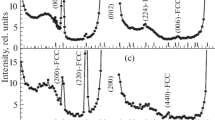Abstract
X-ray diffraction was used to determine temperature ranges of annealings that allow the stabilization of the D03 and B2 superstructures in Fe-Al alloys at room temperature upon cooling them at a given rate. A substantial effect of the long-range-order type on the magnetic properties, such as the magnetic-ordering temperature, average magnetic moment per Fe atom, average hyperfine magnetic field at 57Fe nucleus, and coercive force, is demonstrated using the Fe70Al30 alloy as an example.
Similar content being viewed by others
References
O. Kubashewski, Iron—Binary Alloy Systems (Springer, Berlin, 1982; Metallurgiya, Moscow, 1985).
Binary Alloys Phase Diagrams, Ed. by T. Massalski, (Am. Soc. Met., 1986).
H. Warlimont, “Elektronenmikroskopische Untersuchung der Gleichgewichte and Umwandlungen der α-Eisen-Aluminium-Überstructurphasen,” Z. Metallkd. 60(3), 195–203 (1969).
A. Arrot and H. Sato, “Transition from Ferromagnetism to Antiferromagnetism in Iron-Aluminum Alloys. Experimental Results,” Phys. Rev. 114(6), 1420–1426 (1959).
A. Taylor and P. M. Jones, “Constitution and Magnetic Properties of Iron-Rich Iron-Aluminum,” J. Phys. Chem. Solids 6, 16–37 (1958).
D. R. Noakes, A. S. Arrott, M. G. Belk, et al., “Incommensurate Spin Density Waves in Iron Aluminides,” Phys. Rev. Lett. 91(21), 72011–72014 (2003).
R. Hergt, E. Wieser, H. Gengnageln, and A. Gladun, “The Magnetic Behavior of Fe-Al Alloys of B2-Structure Investigated by Mössbauer Spectroscopy,” Phys. Status Solidi 41, 255–263 (1970).
J. E. Frackowiak, “A Mössbauer Study of Charge Transfer in Ordered Fe3Al Alloys,” Nukleonika 39, 223–232 (1994).
H. Danan and H. Gengnagel, “Ferro-, Antiferro-, and Superparamagnetic Behavior of Fe-Al Alloys,” J. Appl. Phys. 39, 678–679 (1968).
H. Gengnagel, M. J. Besnus, and H. Danan, “Temperature and Field Dependence of the Magnetization of Fe-Al Powders in Cold-Worked and Annealed State,” Phys. Status Solidi A 13, 499–503 (1972).
G. P. Huffman, “Mössbauer Study and Molecular Field Theory of the Magnetic Properties of Fe-Al Alloy,” J. Appl. Phys. 42, 1606–1607 (1971).
E. V. Shelekhov, “Program Package for X-ray Diffraction Analysis of Polycrystals,” in Abstracts of Papers of the National Conference on Applications of X-ray, Synchrotron, Neutron, and Electron Radiation for Material Studying (Dubna, 1997), Vol. 3, pp. 316–320.
Author information
Authors and Affiliations
Additional information
Original Russian Text © E.P. Elsukov, E.V. Voronina, A.S. Shuravin, A.V. Zagainov, A.V. Korolev, S.K. Godovikov, E.A. Pechina, A.E. Elsukova, 2006, published in Fizika Metallov i Metallovedenie, 2006, Vol. 102, No. 1, pp. 733–739.
Elsukov and Elsukova are also known by the names Yelsukov and Yelsukova, respectively. The names used here are the transliterations under the BSI/ANSI scheme adopted by this journal.—Ed.
Rights and permissions
About this article
Cite this article
Elsukov, E.P., Voronina, E.V., Shuravin, A.S. et al. Structure of the Fe100−x Alx alloys (25 < x < 35 at. %) annealed in a temperature range of 400–800°C and the effect of the ordering type on the magnetic properties. Phys. Metals Metallogr. 102, 55–60 (2006). https://doi.org/10.1134/S0031918X06070076
Received:
Issue Date:
DOI: https://doi.org/10.1134/S0031918X06070076




